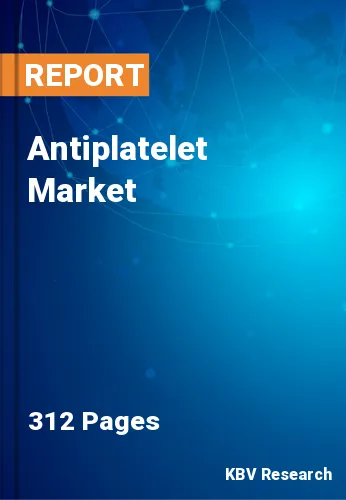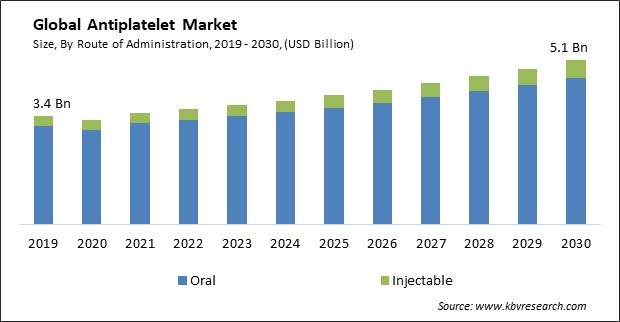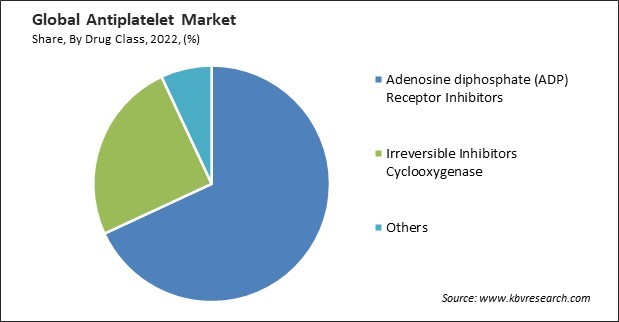
The Global Antiplatelet Market size is expected to reach $5.1 billion by 2030, rising at a market growth of 4.7% CAGR during the forecast period. In the year 2022, the market attained a volume of 430.4 million Units experiencing a growth of 3.4 % (2019-2022).
Developing P2Y12 receptor inhibitors, such as clopidogrel, prasugrel, and ticagrelor, marked a significant advancement. The concept of DAPT, which combines aspirin with an ADP receptor inhibitor (e.g., clopidogrel), has become a standard of care in many cardiovascular conditions. Therefore, Adenosine diphosphate (ADP) Receptor Inhibitors segment would generate $2,451.9 million revenue in the market in 2022. As a result, these drugs target the P2Y12 receptor on platelets and are more specific and potent than earlier antiplatelet medications. Research has confirmed the benefits of DAPT in preventing stent thrombosis and reducing the risk of cardiovascular events. Some of the factors impacting the market are increasing prevalence of cardiovascular diseases, rising proportion of aging population and cost and accessibility of antiplatelet.

Lifestyle factors such as sedentary lifestyles, unhealthy diets, smoking, and obesity, as well as non-modifiable risk factors such as genetics and aging, contribute to the development of CVDs. These risk factors are prevalent in many regions, further driving the demand for preventive and therapeutic interventions, including antiplatelet medications. Patients who have already experienced a cardiovascular event, such as a heart attack or stroke, require long-term antiplatelet therapy to reduce the risk of recurrent events. The growing number of individuals with a history of CVD contributes to sustained demand for antiplatelet drugs. Additionally, the global population is aging, and elderly individuals are at a higher risk of CVD. As the elderly population grows, the need for antiplatelet medications to manage and prevent heart and vascular conditions increases. Aging is a significant risk factor for cardiovascular diseases (CVDs). Older individuals are more likely to develop coronary artery disease, stroke, and peripheral artery disease. As the population ages, the incidence of these conditions rises, leading to an increased demand for antiplatelet therapy to manage and prevent CVDs. Therefore, the increasing prevalence of cardiovascular diseases is one of the most significant drivers of the market and the aging population is a substantial demographic trend that profoundly impacts the market.
However, access to healthcare and medications, including antiplatelet therapy, varies significantly between high-income and low-income countries. Disparities in healthcare infrastructure and resources can limit access to essential medications in underserved regions. Patients in rural or remote areas face challenges accessing healthcare facilities and pharmacies where antiplatelet medications are available. Geographic barriers can lead to delays in treatment. Periodic shortages of certain medications, including antiplatelet drugs, can disrupt patient care and lead to difficulty obtaining essential medications. Cost and accessibility challenges are significant barriers that affect the market and can impact patients' access to essential medications.
Additionally, numerous nations' healthcare systems were significantly focused on addressing the immediate threats posed by COVID-19. This shift in priorities led to disruptions in routine healthcare services, including managing chronic conditions like cardiovascular diseases. As a result, some patients experienced delays in receiving antiplatelet therapy or regular check-ups. During the pandemic, there was a shift in prescription patterns. Some healthcare providers altered treatment plans to reduce the need for in-person visits and laboratory monitoring. This led to changes in the choice of antiplatelet drugs or dosage adjustments. Furthermore, the increase in demand for parenteral antiplatelet drugs during the pandemic positively impacted the market's growth.
Based on route of administration, the market is classified into oral and injectable. In 2022, the oral segment witnessed the largest revenue share in the market. Aspirin is one of the oldest and most widely used oral antiplatelet medications. It works by irreversibly inhibiting cyclooxygenase-1 (COX-1), which reduces the production of thromboxane A2 (TXA2), a platelet aggregator. Aspirin is often used in low doses to prevent cardiovascular events like heart attacks and strokes. Oral antiplatelet medications are a significant component of the antiplatelet market. These medications are taken by mouth to inhibit platelet aggregation, reduce the risk of blood clot formation, and prevent or manage various cardiovascular conditions.
By drug class, the market is categorized into adenosine diphosphate (ADP) receptor inhibitors, irreversible inhibitors cyclooxygenase, and others. The irreversible inhibitors cyclooxygenase segment covered a considerable revenue share in the market in 2022. Irreversible COX inhibitors like aspirin often combine with ADP receptor inhibitors (like clopidogrel) to provide dual antiplatelet therapy (DAPT). DAPT is commonly prescribed after coronary stent placement and in patients with acute coronary syndrome (ACS) to prevent blood clot formation and lower the risk of cardiovascular events.

On the basis of distribution channel, the market is divided into hospital pharmacies, drug store & retail pharmacies, and online providers. The drug store and retail pharmacies segment dominated the market with maximum revenue share in 2022. Local communities ' drug stores and retail pharmacies ensure that a wide range of antiplatelet medications, including over-the-counter aspirin and prescription drugs like clopidogrel, ticagrelor, and others, are readily available to patients. This increased accessibility is crucial for both acute and chronic conditions. The expansion of drug store and retail pharmacies enhances patient access and contributes to medication safety, education, and adherence.
| Report Attribute | Details |
|---|---|
| Market size value in 2022 | USD 3.6 Billion |
| Market size forecast in 2030 | USD 5.1 Billion |
| Base Year | 2022 |
| Historical Period | 2019 to 2021 |
| Forecast Period | 2023 to 2030 |
| Revenue Growth Rate | CAGR of 4.7% from 2023 to 2030 |
| Number of Pages | 312 |
| Number of Table | 580 |
| Quantitative Data | Volume in Units, Revenue in USD Million, and CAGR from 2019 to 2030 |
| Report coverage | Market Trends, Revenue Estimation and Forecast, Segmentation Analysis, Regional and Country Breakdown, Companies Strategic Developments, Company Profiling |
| Segments covered | Route of Administration, Drug Class, Distribution Channel, Region |
| Country scope | US, Canada, Mexico, Germany, UK, France, Russia, Spain, Italy, China, Japan, India, South Korea, Singapore, Malaysia, Brazil, Argentina, UAE, Saudi Arabia, South Africa, Nigeria |
| Growth Drivers |
|
| Restraints |
|
Region-wise, the market is analysed across North America, Europe, Asia Pacific, and LAMEA. In 2022, the North America region led the market by generating the highest revenue share. North America has a high prevalence of cardiovascular diseases, including stroke, coronary artery disease, and peripheral artery disease. These conditions often require antiplatelet therapy to reduce the risk of thrombotic events like heart attacks and strokes. A wide range of antiplatelet drugs is available in North America, including aspirin, clopidogrel (Plavix), ticagrelor (Brilinta), prasugrel (Effient), and others. These drugs are used for various indications, such as acute coronary syndrome, post-stent placement, and secondary prevention.
Free Valuable Insights: Global Antiplatelet Market size to reach USD 5.1 Billion by 2030
The market research report covers the analysis of key stake holders of the market. Key companies profiled in the report include Cipla Limited, Glenmark Pharmaceuticals Limited, Bayer AG, AstraZeneca PLC, Daiichi Sankyo Company, Limited, Eli Lilly And Company, Otsuka Pharmaceutical Co., Ltd., Sanofi S.A. , Lupin Limited and Chiesi Farmaceutici S.p.A.
By Route of Administration (Volume, Million Units, USD Million, 2019-2030)
By Drug Class (Volume, Million Units, USD Million, 2019-2030)
By Distribution Channel (Volume, Million Units, USD Million, 2019-2030)
By Geography(Volume, Million Units, USD Million, 2019-2030)
The Market size is projected to reach USD 5.1 billion by 2030.
Increasing prevalence of cardiovascular diseases are driving the Market in coming years, Cost and accessibility of antiplatelet restraints the growth of the Market.
Cipla Limited, Glenmark Pharmaceuticals Limited, Bayer AG, AstraZeneca PLC, Daiichi Sankyo Company, Limited, Eli Lilly And Company, Otsuka Pharmaceutical Co., Ltd., Sanofi S.A. , Lupin Limited and Chiesi Farmaceutici S.p.A.
In the year 2022, the market attained a volume of 430.4 million Units experiencing a growth of 3.4 % (2019-2022).
The Adenosine diphosphate (ADP) Receptor Inhibitors segment is capturing maximum revenue in the Market by Drug Class in 2022; thereby, achieving a market value of $3.4 Billion by 2030.
The North America region dominated the Market by Region in 2022; thereby, achieving a market value of $2.05 Billion by 2030.
Our team of dedicated experts can provide you with attractive expansion opportunities for your business.
